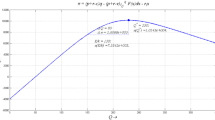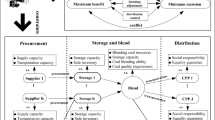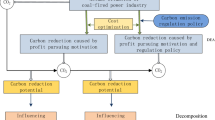Abstract
China’s carbon peak strategy constrains industry’s carbon footprint, limiting the total amount of electricity production from coal burning, rendering electricity a relatively scarce resource and affecting manufacturing enterprises’ production and operation activities. To address these circumstances, this paper applies a non-cooperative game model to describe the electricity resource distribution and product production process under enterprises’ competitive state, proposing an optimal electricity distribution analysis framework for manufacturing enterprises. The results of optimal electricity distribution for six subindustries in the ‘three innovations’ manufacturing industries (referring to a collection of economic activities to establish new industries, new formats and new business models) are analysed to examine the difference in electricity consumption efficiency among industries. The electricity quota of each industrial chain significantly differs before and after redistribution;therefore, the industrial differences of optimal electricity distribution are further explored from the perspective of industrial chains, revealing the supply–demand relationship of upstream, middle and downstream enterprises. Finally, corresponding policy suggestions and directions for further research are presented.











Similar content being viewed by others
References
Beasley JE (2003) Allocating fixed costs and resources via data envelopment analysis. Eur J Oper Res 147(1):198–216
Behrang MA, Assareh E, Assari MR, Ghanbarzadeh A (2011) Assessment of electricity demand in iran’s industrial sector using different intelligent optimization techniques. Appl Artif Intell 25(1–4):292–304
Boran FE, Etoz M, Dizdar E (2013) Is Nuclear Power an Optimal Option for Electricity Generation in Turkey? Energy Sources Part B- Economics Planning and Policy 8(4):382–390
Chen W, Ma YK, Bai CG (2021) The Impact of Carbon Emission Quota Allocation Regulations on the Investment of Low-Carbon Technology in Electric Power Industry Under Peak-Valley Price Policy. IEEE Transactions on Engineering Management, Early Access
Cordon O, Herrera F, Sánchez L (1999) Solving electrical distribution problems using hybrid evolutionary data analysis techniques. Appl Intell 10(1):5–24
Dong F, Hua YF, Yu BL (2018) Peak Carbon Emissions in China: Status, Key Factors and Countermeasures-A Literature Review. Sustainability 10(8):2895
Du J, Cook WD, Liang L, Zhu J (2014) Fixed cost and resource allocation based on dea cross-efficiency. Eur J Oper Res 235(1):206–214
Elliott R, Sun PY, Zhu T (2018) Electricity prices and industry switching: evidence from Chinese manufacturing firms. Energy Econ 78:567–588
Eguchi S, Takayabu H, Lin C (2021) Sources of inefficient power generation by coal-fired thermal power plants in China: A metafrontier DEA decomposition approach. Renew Sustain Energy Rev 138:110562
Felder FA (2016) Financial transmission rights: analysis, experiences and prospects. Energy J 37(1):292–295
Foellmi R, Rosenblatt-Wisch R, Schenk-Hoppe KR (2011) Consumption paths under prospect utility in an optimal growth model. J Econ Dyn Control 35(3):273–281
Fritz V, Menocal AR (2007) Developmental states in the new millennium: concepts and challenges for a new aid agenda. Dev Policy Rev 25(5):531–552
Fu T, Jian Z (2020) A developmental state: how to allocate electricity efficiently in a developing country. Energy Policy 138:111231
Ho MH, Hnaien F, Dugardin F (2021) Electricity cost minimisation for optimal makespan solution in flow shop scheduling under time-of-use tariffs. Int J Prod Res 59(4):1041–1067
Huang YJ, Chen KH, Yang CH (2010) Cost efficiency and optimal scale of electricity distribution firms in Taiwan: An application of metafrontier analysis. Energy Econ 32(1):15–23
Li Y, Yang F, Liang L, Hua Z (2009) Allocating the fixed cost as a complement of other cost inputs: a DEA approach. Eur J Oper Res 197(1):389–401
Li Y, Lin L, Dai Q, Zhang L (2020) Allocating common costs of multinational companies based on arm’s length principle and Nash non-cooperative game. Eur J Oper Res 283:1002–1010
Yin JH, Wang S, Gong LD (2018) The effects of factor market distortion and technical innovation on China’s electricity consumption. J Clean Prod 188:195–202
Lin B, Ouyang X (2014) Electricity demand and conservation potential in the Chinese nonmetallic mineral products industry. Energy Policy 68:243–253
Li FY, Liu WW, Bi KX (2021) Exploring and visualizing spatial-temporal evolution of patent collaboration networks: a case of China’s intelligent manufacturing equipment industry. Technol Soc 64:101483
Li JH, Luo YC, Wei SY (2022) Long-term electricity consumption forecasting method based on system dynamics under the carbon-neutral target. Energy 244:122572
Li K, Bian H, Liu C, Zhang D, Yang Y (2015) Comparison of geothermal with solar and wind power generation systems. Renew Sustainable Energy Reviews 42:1464–1474
Liu Z, Adams M, Cote RP, Geng Y, Chen Q, Liu W et al (2017) Comprehensive development of industrial symbiosis for the response of greenhouse gases emission mitigation: challenges and opportunities in china. Energy Policy 102(3):88–95
Tarancon MA, Rio PD, Callejas F (2011) Determining the responsibility of manufacturing sectors regarding electricity consumption. the spanish case. Energy 36(1):46–52
Wang Y, Li L (2014) Time-of-use based electricity cost of manufacturing systems: modeling and monotonicity analysis. Int J Prod Econ 156:246–259
Oezak O (2014) Optimal consumption under uncertainty, liquidity constraints, and bounded rationality. J Economic Dynamics Control 39:237–254
Qiao H, Zhang Z, Su Q (2021) The optimal hourly electricity price considering wind electricity uncertainty based on conditional value at risk. Int J Green Energy 6:1–13
Sarkar V, Khaparde SA (2008) Introduction to multidimensional financial transmission rights. IEEE Trans Power Syst 23(1):47–57
Srinivasan D, Woo D (2006) Evolving cooperative bidding strategies in a power market. Appl Intell 29(2):162–173
Srinivasan P, Shekhar A (2020) Internalizing the external cost of gaseous and particulate matter emissions from the coal-based thermal power plants in India. Part Sci Technol 39(5):1–9
Xie QW, Xu QF, Rao KF, Dai QZ (2022) Water pollutant discharge permit allocation based on DEA and non-cooperative game theory. J Environ Manage 302:113962
Yu S, Zheng S, Li X, Li L (2018) China can peak its energy-related carbon emissions before 2025: evidence from industry restructuring. Energy Econ 73:91–107
Zhao X, Bai H, Shi Q, Lu X, Zhang Z (2017) Optimal scheduling of a byproduct gas system in a steel plant considering time-of-use electricity pricing. Appl Energy 195:100–113
Zhang CH, Jiang NY, Su TT, Chen J, Streimikiene D, Balezentis T (2022) Spreading knowledge and technology: Research efficiency at universities based on the three-stage MCDM-NRSDEA method with bootstrapping. Technol Soc 68:101915
Zhang CP, Timothy OR, Zhang Y (2018) Theory and practice of enterprise carbon asset management from the perspective of low-carbon transformation. Carbon Manag 9(1):87–94
Acknowledgements
This research was supported by National Philosophy and Social Science Foundation (No. 21ATJ010; No.20CTJ016), China Postdoctoral Science Foundation (No. 2019M651403) and Zhejiang Province Natural Science Foundation (No. LQ20G010001).
Author information
Authors and Affiliations
Corresponding author
Ethics declarations
Conflict of interest
The authors have no financial or proprietary interests in any material discussed in this article.
Additional information
Publisher’s Note
Springer Nature remains neutral with regard to jurisdictional claims in published maps and institutional affiliations.
Rights and permissions
Springer Nature or its licensor holds exclusive rights to this article under a publishing agreement with the author(s) or other rightsholder(s); author self-archiving of the accepted manuscript version of this article is solely governed by the terms of such publishing agreement and applicable law.
About this article
Cite this article
Zhang, C., Guo, Z., Xu, Z. et al. Optimal electricity distribution of ‘three innovations’ manufacturing enterprises under China’s peak carbon strategy. Appl Intell 53, 14043–14057 (2023). https://doi.org/10.1007/s10489-022-04143-6
Received:
Revised:
Accepted:
Published:
Issue Date:
DOI: https://doi.org/10.1007/s10489-022-04143-6




